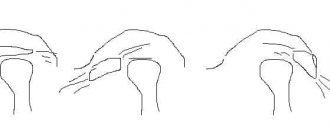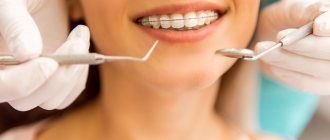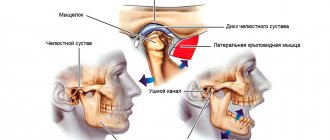Splinting the jaw after a fracture
Splinting a jaw for a fracture is not just a key way to provide medical dental care, but the very first and most important. The cause of its occurrence, location and nature of the damage are not important. Splinting of a damaged jaw in case of a fracture has to be done:
- For fractures with displacement of the facial bones and injuries not associated with displacement.
- For transverse, zigzag, oblique, longitudinal fractures.
- For closed and open injuries of the jaw bones.
- With a simple crack in the maxillofacial region.
- In the treatment of multiple and comminuted fractures.
The specific method of splinting the jaw for fractures depends only on whether the upper or lower jaw was damaged, what type of damage occurred, and how long, in the dentist’s opinion, it will take to restore normal dental function. Dentists use 3 types of splinting of a damaged jaw:
- One-sided - required when only one half of the upper or lower part of the teeth is damaged, with copper wire serving as a splint.
- Double-sided - made to fix the dentition on both sides; thicker and stiffer wire, hooks or rings are used as the base.
- Double-jawed - required when displacement, fragments and other complications occur as a result of trauma, it involves reliable fastening of both jaws to each other.
Additionally, the procedure is accompanied by an x-ray examination, pain relief and antibacterial therapy. It is impossible to solve the problem of a fracture of the lower or upper jaw on your own, since we are talking not only about the need to fix the teeth during complete healing, but also about eliminating complications.
Splinting for a fracture of the lower jaw
Splinting the lower jaw for a fracture is the only possible option for recovery after this type of damage, and therefore is mandatory. This is due to the special mobility of the lower part of the teeth and possible damage to blood vessels, nerves, and muscles located nearby. Injuries are most often located in the chin area, side or corner of the jaw.
Installing a splint on the lower jaw involves surgery, during which the doctor compares the fragments and fixes them in their original place. Most often, fastening is done in the mouth on bone tissue, but some complex fractures require the installation of special devices externally.
The choice of a specific splinting method depends on the type and complexity of the fracture and its location. Incorrect selection of a treatment method for the lower jaw can lead to serious complications, so it is important to contact a specialist with extensive experience, for example, Dr. Sadov’s Center for Comfortable Dentistry. This must be done immediately, immediately after providing first aid to the patient, since any attempt to speak or otherwise move the injured jaw can lead to a worsening of the condition, bleeding, asphyxia and other undesirable consequences.
Splinting of the upper jaw
Fractures of the upper jaw occur much less frequently than the lower jaw. It is less mobile and does not extend, so much more force is required to cause harm. Most often, a fracture of the upper jaw is accompanied by a fracture of the lower jaw, which means a special two-jaw fixation is required. The meaning of the procedure is that both jaws are tightly connected to each other, leaving no free space even for eating. The oral cavity is literally “sutured up” for at least 1 month, and often for a longer period. With this method of splinting, a special load is placed on the teeth, since the fixation is carried out using traction loops. This leads to additional pain.
Types of fractures of the upper jaw are divided into 3 groups according to the location of injury:
- At the lower level, that is, with breaking off part of the maxillary sinus and nasal septum.
- At an average level, it may accompany separation of the jaw from the bones of the skull and nose.
- At the upper level - always accompanied by complete separation from the nose, cheekbones, skull bones and head injury.
As for splinting, there are no differences between the treatment of the upper and lower parts of the jaw and the specific type of device is selected by the treating orthopedic dentist.
Treatment of jaw dislocation
A dislocated jaw is treated simply: the doctor realigns the joint, placing the bone in the right place. Muscle relaxants or painkillers may be needed to relax tight muscles.
Then the jaw must be secured in a stationary state. To do this, the doctor applies a bandage. If the dislocation does not appear for the first time, then surgery will be needed to straighten it.
Recovery after a dislocation lasts 6 weeks. At this time, you should not open your mouth wide. When yawning and sneezing, the lower jaw should be supported with your hands.
Rubber bands for splinting
In some cases, splinting with wire requires additional fastening with special rubber bands to fix the jaws in a closed state. The main purpose of the rubber bands is to move the teeth in the direction in which they were originally. There are many advantages of elastic material:
- The rubber bands are easy to cut and remove, which is especially important if the patient has suffered a head injury and there is a risk of complications in the form of epileptic seizures, fainting and other neurological disorders.
- With the correct tension, the elastic bands allow you to take food through a tube; a tighter fastening often leads to tube feeding.
- Damaged rubber bands can be easily replaced, while damage to the metal structure will require serious medical intervention.
The decision to install rubber bands for splinting must be made by a doctor and most often they begin to be used only when primary healing of the injured jaw has occurred. In the first stages, as a rule, more rigid fixation is required. In any case, consultation with a specialist is required, who, based on the condition of the teeth, the nature of the damage, and the general condition of the patient, will be able to determine the most suitable type of splinting. Dr. Sadov’s clinic in Moscow employs professionals who have completed internships abroad and clearly understand the specifics of dental orthopedics.
How to determine how long the retention period lasts?
The doctor can guess what risks a particular patient has. But it is difficult to predict this in advance; the standard period is no less than the treatment period.
Since the treatment itself with an orthodontist is long and expensive, in order not to risk the result, observation with an orthodontist for another 1–2 years is usually recommended.
What rules are followed to prevent the bite from returning to its previous position?
- Wearing a mouthguard and retainer.
This is the most basic thing. The doctor decides whether to install a retainer - a thin and inconspicuous wire similar to an arch of braces that is attached to the inside of the teeth, but most often this is done.
Retainer placed on teeth
Retainers also do not replace wearing a mouthguard. Aligners are used by those who wore braces, and continue to be worn by those who were treated with aligners. Usually it is enough to wear mouth guards at night. They are made according to the teeth model at the very end of treatment, when the desired result is obtained.
Although mouthguards primarily maintain the position of the teeth in a row, they also affect the bite. Since if the teeth are in the correct position, then the occlusion (closing) of the teeth is preserved.
- Visiting an orthodontist.
A scheduled appointment is recommended once every 6 months (in the first year and a half after the end of treatment), and then once a year. The patient himself may not notice slight deviations of the teeth from the correct position, but the doctor usually sees this immediately. Small violations can be easily eliminated: it is enough to make a new mouth guard, which will quickly return the result and maintain it.
- Maintaining general health.
Adequate sleep, reduced stress, good nutrition without restrictions on basic foods, especially those containing calcium and phosphorus.
At first glance, it seems that stress and general fatigue do not affect the condition of the teeth, but many doctors have noted that there is a negative impact.
- Continue treatment if required.
Sometimes, after correcting the bite, prosthetics are needed if, for example, the upper “double” incisors were initially missing (this is the most common case of edentia) or if some teeth were removed before treatment. In this case, it is recommended to undergo comprehensive treatment, that is, first with an orthodontist and then with an implantologist. It is this approach that guarantees maximum restoration of all dental functions and the best maintenance of results in the future.
How to eat after splinting
Hard splinting involves difficulties in eating, but at the same time, during this period it is especially important for the body to receive a large amount of vitamins, minerals, and nutrients required for the speedy regeneration of bone tissue. The patient's menu after splinting usually includes various nutritious broths, fruit, vegetable and meat purees (baby purees), semi-liquid and liquid porridges. It is necessary to monitor the content of large amounts of protein, calcium, phosphorus, and zinc in food. It is possible to replace some meals with infant formula or sports nutrition, since in both cases the content of substances necessary for the body is high.
It is strictly forbidden to drink any alcoholic beverages during treatment, especially if, in addition to the jaw, there is also a traumatic brain injury. In addition, you should not try to eat solid foods that require chewing. Firstly, it can cause severe pain. Secondly, it can lead to improper healing of damaged bone tissue.
If you receive injuries that have symptoms similar to a jaw fracture: acute pain, bleeding, immobilization of the jaw, and so on, you should immediately seek professional help. Attempts at self-treatment or complete lack of treatment cause irreparable harm and lead to loss of dental functionality.
How much does it hurt?
Most of the treatment time is pain-free. Typically, discomfort of varying severity occurs only in the first days after the start of treatment or activation of the system.
What severity of pain can there be at this time?
- Minor pain occurs when chewing and biting into hard foods (for example, meat or a chocolate bar). At the same time, eating soft food does not hurt.
- Aching pain with any food intake, even soft, but at rest nothing bothers you.
- Pain in the teeth and gums persists all the time, it is difficult even to drink water.
- The unpleasant sensations are accompanied by irritation of the mucous membranes of the lips and cheeks (sometimes this happens to those who wear braces, but not when wearing aligners).
- In addition to tooth pain, jaw joints may also hurt, and due to tension in the muscles of the face and neck, the head may also hurt. In rare cases, insomnia may occur.
Pain during bite correction is normal and usually goes away within 1–3 days.
How will your treatment proceed?
It is impossible to predict this, since all reactions, as well as the pain threshold, are individual. Some patients experience minimal discomfort, others experience pain, but only in the first days after activation of the system. Still others recall that discomfort, to one degree or another, accompanied up to half of the treatment time. For some, moving teeth itself is painful, but for others, just correcting the bite with traction rods is painful.
It should be noted that the type of braces (metal, ceramic, etc.) does not affect the degree of pain, since they work the same way. But aligners, by all accounts, are much more comfortable to wear. They are gentler than braces, especially at the beginning of treatment, so they almost never cause severe pain. In addition, due to their smooth surface, the aligners cannot scratch the inside of the lips and cheeks.
The aligners are smooth, follow the shape of the teeth, so they do not irritate the mucous membranes








